There are many different types of telescopic magnifying glasses. Some are readily available commercially and others must be custom-made for you and your needs. In this article, you will learn more about our experience with telescopic magnifying glasses and what to look for when buying them.
Extremely important is that before buying you should contact a specialized optician who will measure you optimally and has experience with telescopic magnifying glasses. The reason is that the required magnification of telescopic magnifying glasses is related to your visual performance and activities.
Ideally, the optician will also have different telescopic magnifying glasses ready to test directly within the measurement and you can experience the differences directly. The following variants are available:
telescopic magnifying glasses in the form of:
- A clip that can be put on if necessary
- Fixed telescopic magnifying glasses that are integrated into the lens
- Telescopic magnifying glasses that are only held by the lens
All these types of telescopic magnifying glasses are available in different magnifications, with magnifications of 2x-10x being used in most cases. There are systems that are variable in the distance at which you can see sharply and those that work only for one distance.
The weight of the telescopic magnifying glasses can also vary greatly and is usually between 25 to 50grams per side. Let us talk first about different magnifications how this influences your experience with telescope loupe glasses.
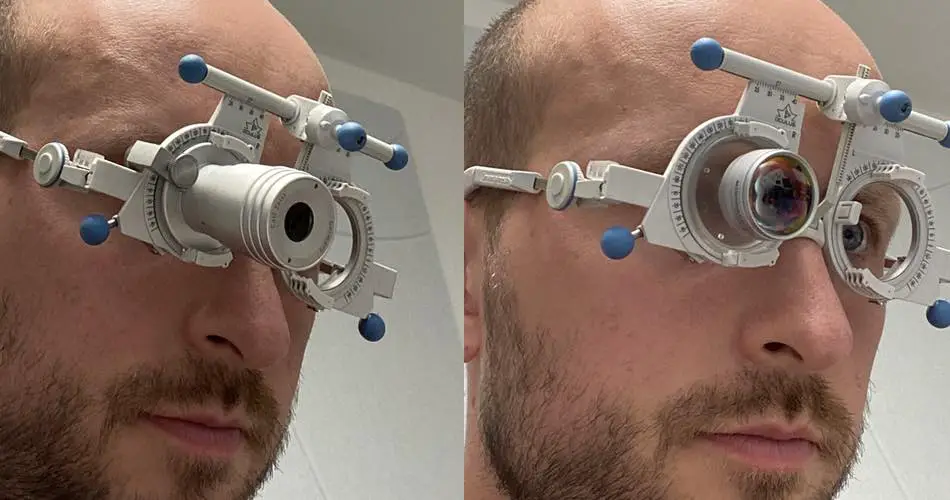
How to Choose the Right Magnification for Your Telescope Loupe Glasses?
The magnification is chosen after the optician made an eye test and knows your visual acuity. He or she now knows your individual ability to recognize small details with precision. Visual acuity is expressed in different formats. For the sake of simplicity, we only focus on the Snellen imperial and the decimal format.
Most people have 20/20 vision (Snellen imperial) which is comparable to a visual acuity of 1.0 (decimal format) which is a visual acuity of 100%. That is not the best possible but most people fall in this range.
For reading a book 20/40 or 0.5 (50%) is required in combination with your visual aid. When you as the examinee look at the eye chart it may be possible for you to read the chart for 6/60 or 0.10 (10%) and now you can not go smaller. No matter what the optician does in combination with normal prescription lenses.
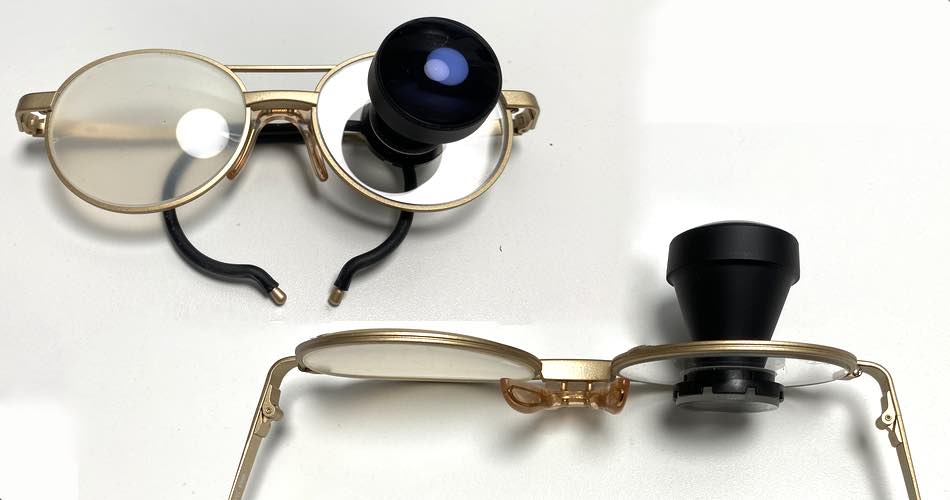
In such a case the optician can bump up the magnification with telescope loupe glasses. What he or she needs to do is to add a magnification of 5x. This is pretty simple. The optician uses the value of the needed visual acuity for the task and divides it with your individual visual acuity. This means in our example reading a book needs 20/40 vision divided by 6/60 leads to a needed magnification of 5x. With some telescope loupe glasses, the optician needs to add compensation for the accommodation to make the system work.
In our example, we ended up with a needed magnification of 5x. In reality depending on the lighting which is used you may go a little higher or lower with the magnification. This depends on individual factors like contrast sensitivity which is not taken into account. Only the testing shows how this works for the wearer. The higher the magnification is chosen the smaller the more unstable the picture gets.
This means you can see movements of the head or tremble faster. Even if it is just really subtle. In addition to that, the field of view always gets smaller the higher the magnification. This means you may end up only seeing a fraction of a sentence or a word and you need to move your head very advisedly to be able to read with telescope loupe glasses. Especially with those ones that have high magnifications. This is hard for a lot of elderly people.
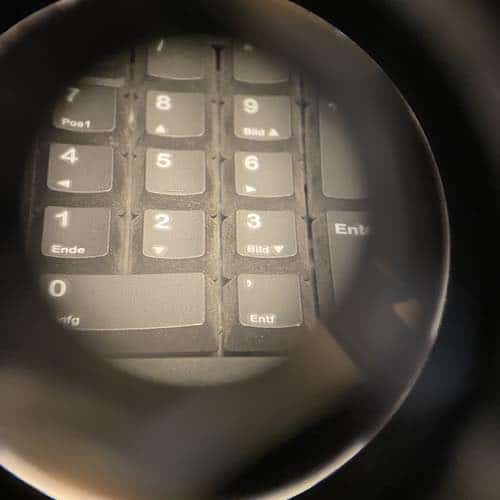
Because when people think about magnification they do not necessarily link it to just seeing a cutout of the whole picture. But this is exactly what you get with telescope loupe glasses. And this is also the reason for producing a magnification which is just right for reading a book.
You could theoretically produce loupe telescope glasses that make it possible to see even smaller text or extremely small details. But for the average user, this means shaking or even finding the spot in the book where you want to read becomes not possible due to the small cut out I described earlier. You would have practically no orientation.
This is why the guiding principle for the optician is to give you as much magnification needed to make you read for example. But at the same time, the magnification should be as low as possible so you have a bigger cutout and an easier time using your telescope loupe glasses. For some telescope loupe glasses, an add-on lens is available so you can bump up the magnification just when you clip on the lens.
Practical Consideration Before Buying Telescope Loupe Glasses
What do you want to do with the telescope loupe glasses? If you need to accomplish very complex tasks then you probably benefit from telescope loupe glasses that use two eyepieces. Only then you will be able to see binocular, stereoscopic near vision. Or in other words, you will experience the depth of the room you use the glasses in.
One example is the telescope loupe glasses KS/KF titan from Zeiss. It looks very similar to the variant that I carry in the picture below. This is a Kepler telescope loupe system with magnifications from 3.2x to 8x. It provides working distances between 190 – 500 mm.
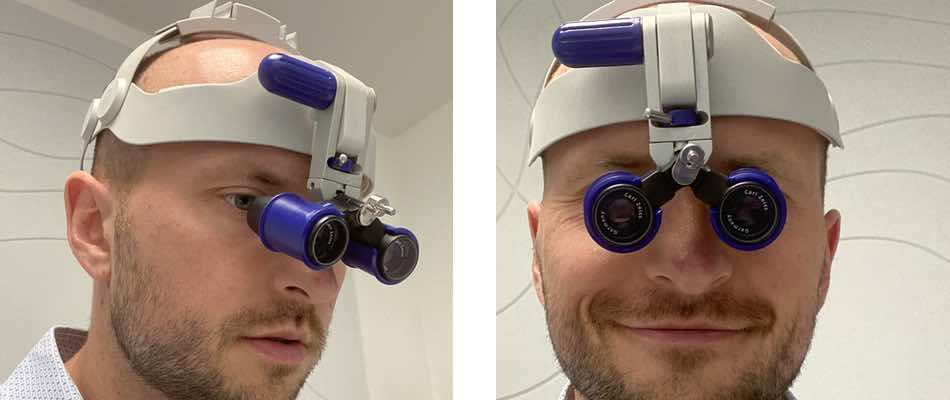
If you have to stand upright all day and the telescopic loupe glasses are not aligned at the optimal angle to where you are looking, you compensate with your neck. You then take your chin close to your sternum for longer periods of time.
This should not be, because then tensions are pre-programmed. The simpler variant is to use a prism wedge. This wedge ensures that the eyepieces are aligned at a certain angle in front of your eye. This way you always look comfortably through the line of sight without having to adopt an unnatural position.
When the telescope loupe glasses are used at work, mostly eyepieces for both eyes are used at the same time. These can then usually not be changed in the distance of the focus. In the private sector, telescope loupe glasses are mostly used by people with severe vision impairments, and the eyepiece is only used by the better eye.
As you can see from the picture below, there are many different eyepieces. These different eyepieces differ in that you can see different distances in space and also in the size of the field of view. It also comes with variants that you can see in the picture below to different lever ratios due to the different weights. To compensate, a thicker mineral lens can be used on the other side of the glasses.
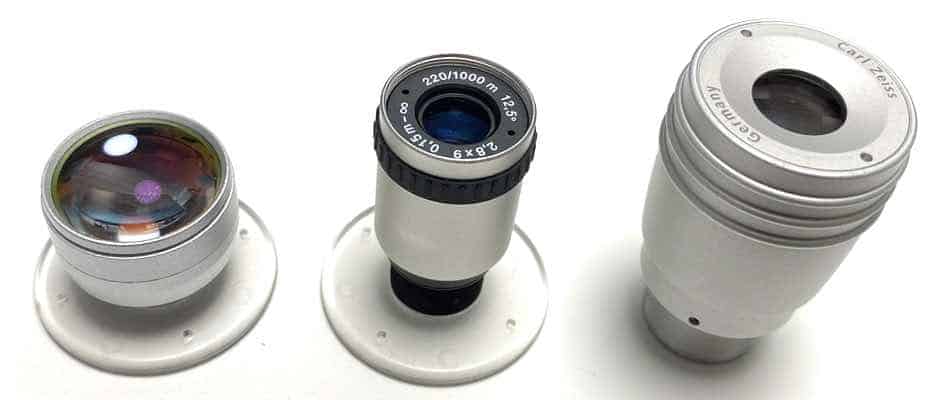
Prices
You can get telescope magnifying glasses from $80 to $2500. The cheapest ones do not offer any possibility for individualization options like the installation of your own eyeglass prescription or an anatomical fitting.
These inexpensive glasses are called MAXTV and MAXDETAIL from Eschenbach, for example, and are available online and locally from your optician. High-end versions like the KS/KF from Zeiss cost around $2000 and offer many adjustment options in addition to the much better optics.
What Is the Difference Between a Galilean System and a Kepler System for Telescopic Magnifiers?
With the Galilean systems, one has a larger field of view, with the Keplerian telescopes one can realize higher magnifications.
